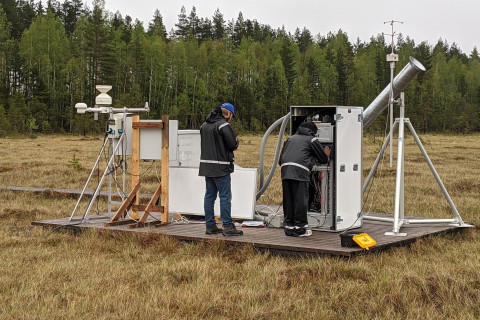Boreal wetlands are a significant source of isoprene and terpenes, a class of highly reactive organic compounds that have a substantial impact on the Earth’s climate, according to a new study led by the University of Eastern Finland and published in Atmospheric Chemistry and Physics. The study was conducted in collaboration between the University of Eastern Finland, the University of Helsinki, the Finnish Meteorological Institute, the Institute of Environmental Assessment and Water Research in Spain, and the University of California Irvine in the US.
The researchers used a combination of field measurements and modelling to investigate the emission rates of isoprene and terpenes from boreal wetlands. Boreal wetlands cover a substantial fraction of the land mass in the northern latitudes, from northern Europe to Siberia and Canada. The team found that these emissions are much higher than previously thought and that they exhibit a particularly strong exponential temperature response, making boreal wetlands a potentially significant source of these compounds due to global warming.
“Our study shows that boreal wetlands are a large source of isoprene and terpenes, which contribute to the formation of secondary organic aerosol and ozone. The isoprene and terpene emissions from these wetlands have been understudied. We used an ecosystem-scale eddy covariance measurement technique to quantify the emissions from a boreal wetland during the unusually warm early summer of 2021,” says first author, Doctoral Researcher Lejish Vettikkat of the University of Eastern Finland.
The emission rates of isoprene and terpenes from boreal wetlands are dependent on temperature, solar radiation, and vegetation leaf area (i.e., wetland grasses and shrubs). Most strikingly, the measurements revealed a much stronger response of these emissions to unusually high temperatures (above 30 °C). Moreover, this response persisted for a period of time after the event, indicating a heat stress reaction by the plants that are not acclimated to these high temperatures. The team also determined the emissions of a previously undetected class of larger terpenes, called diterpenes, which could especially efficiently form aerosols, which influence the Earth's radiation balance, mostly via a cooling effect.
“Our results suggest that boreal wetlands could have a significant impact on the Earth’s climate system, especially as temperatures continue to rise. It is important that we continue to study and monitor these emissions to better understand their impacts on a larger, global scale,” notes Associate Professor Siegfried Schobesberger of the University of Eastern Finland.
The researchers hope that their work will help to inform the development of more effective strategies for assessing emissions from boreal wetlands and their impact on the climate. This study underscores the need for continued research into the complex interactions between these understudied ecosystems and the Earth’s climate system.
Research article: "High emission rates and strong temperature response make boreal wetlands a large source of isoprene and terpenes,": https://doi.org/10.5194/acp-23-2683-2023.

The innovative sampling design was home-built for the study, enabling accurate ecosystem-scale measurements of emissions via fast response and low losses. A high flow (5000 litres per minute) through the chimney inlet enabled sampling of the sticky highly reactive organic compounds without any inlet wall losses. A 3-D sonic anemometer is mounted above the inlet to measure wind speed in all 3 directions enabling the researchers to do eddy covariance. The state-of-the-art Vocus proton transfer mass spectrometer is in a weather-proof, air-conditioned box. Photo by Lejish Vettikkat.





